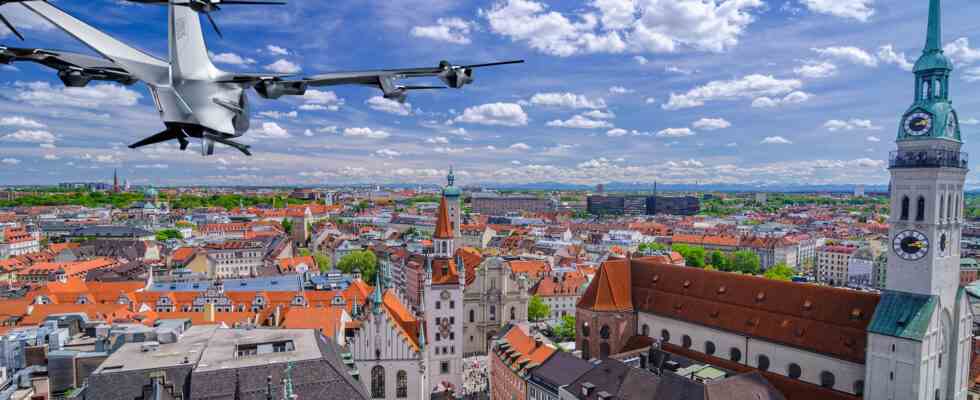Status: 04.05.2022 18:05
By the end of the decade, passengers should be able to travel in air taxis. But many questions remain open. The aviation group Airbus wants to clarify this together with partners – for example what landing pads should look like.
In the Airbus computer animation, the landing pad for the air taxis basically looks like a helipad – only the architecture is a bit more futuristic. The experts call the take-off and landing sites for electrically operated air taxis, which take off vertically, vertiports. In fact, the developers will probably work less on the architecture than on the technical details for the vertiports.
Because regulations and approval procedures for vertiports do not yet exist in Germany. They want to be involved in this, says Ralf Gaffal, Managing Director of Flughafen München International GmbH. According to Gaffal, there could be landing pads on office buildings and residential buildings, as well as at airports or in more remote regions “like the Bavarian Forest”. In this way, smaller communities could be better connected.
Aviation safety, universities and railways involved
Flying taxis over villages and towns – what still sounds like science fiction should become reality in just under ten years. At least that’s the goal at Airbus. Because by 2030, paying passengers could already be on board on the first test routes, said Markus May, Managing Director at Airbus Urban Mobility BR. Then probably together with a pilot and not yet autonomously.
In a large research project of the aviation group Airbus together with 27 partners, the prerequisites for practical operation with air taxis in Germany are to be created from now on. The “Air Mobility Initiative” has now been presented in Munich. In addition to the Airbus Group, which is working on the development of an air taxi, companies involved in flight safety, universities and Deutsche Bahn are also involved. The Free State of Bavaria is funding the project with a total of 17 million euros over the next three years. Another 24 million euros will come from the federal government.
The city of Ingolstadt is also involved in the project. According to business consultant Georg Rosenfeld, she hopes for jobs in the future. Test flights for air taxis are already taking place on a large airfield in Manching near Ingolstadt. The Ingolstadt member of the Bundestag Reinhard Brandl (CSU) said at the press conference that it is not decisive whether the first commercial air taxis will be in the air in five or ten years, but who gets them into the air. There is tough global competition. This competition will not be won by a single company, but by a team made up of aircraft manufacturers, state certification authorities, municipalities and landing field operators. The project hopes to achieve just that.
Aviation expert sees other companies ahead
In the end, will Airbus really have the edge? At its plant in Donauwörth in northern Swabia, the aviation group is currently developing and building its second air taxi – this time with wings. “CityAirbus NextGen” is the name of the aircraft, which looks like a drone with wings. It should be up to 120 kilometers per hour fast and have a range of 80 kilometers. A first test flight is planned for next year. Airbus tried out the first air taxi without wings, weighing around two tons, on numerous test flights last year.
The aviation expert Florian Holzapfel, Professor of Flight System Dynamics at the Technical University of Munich, sees flying in an air taxi as a “gigantic opportunity”. In his estimation, however, it is not the large aviation groups that are at the forefront of development, but above all the new, smaller companies – for example the company Autoflight, which soon wants to do test flights in Augsburg. The company is “technically incredibly far,” Holzapfel said BR already said in January. All in all, Bavaria is developing into a center for the development of air taxis, which is also due to the funding, says Holzapfel.
The fact that Airbus is now moving ahead with the infrastructure research project and so far no other air taxi developers are involved could be a strategy to make up for possible development backlogs. After all, you not only need a reliable aircraft, but also permits, landing pads, charging options for the batteries – and acceptance by the population. That is why Airbus wants to make an effort in the project. Because a flight should initially be something for wealthier passengers. But everyone has to endure the aircraft noise. According to Airbus, the new air taxi is only 65 to 70 decibels loud. The conventional, kerosene-powered helicopters would have up to 90 decibels.

